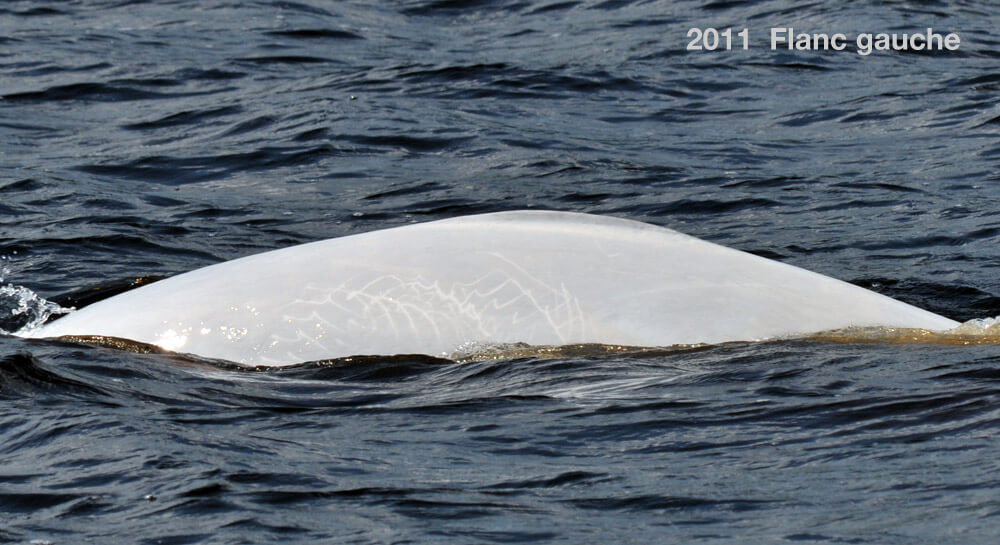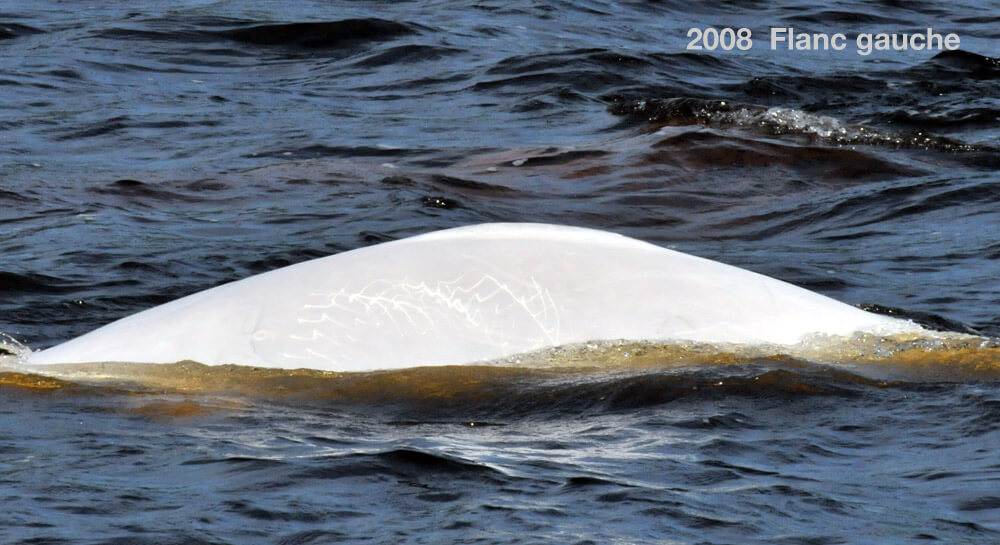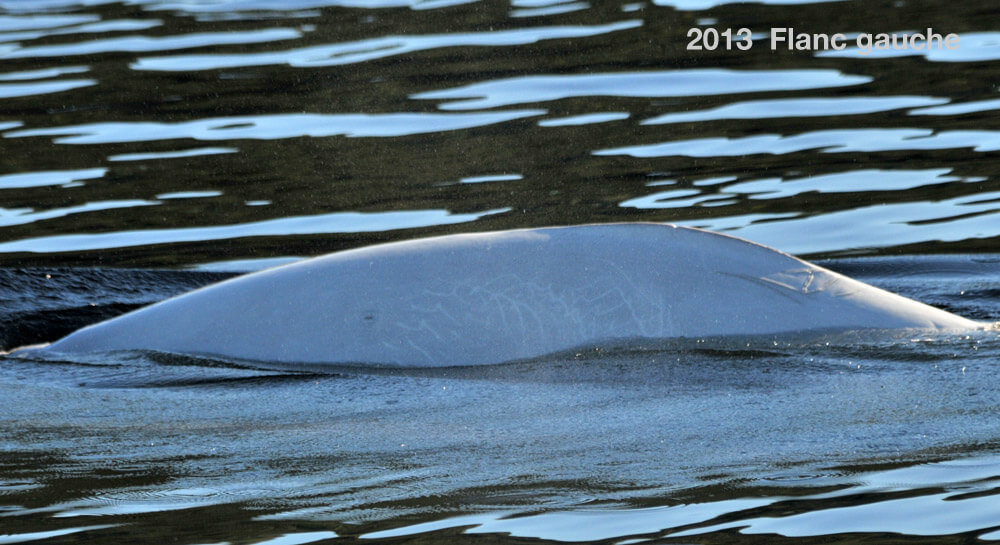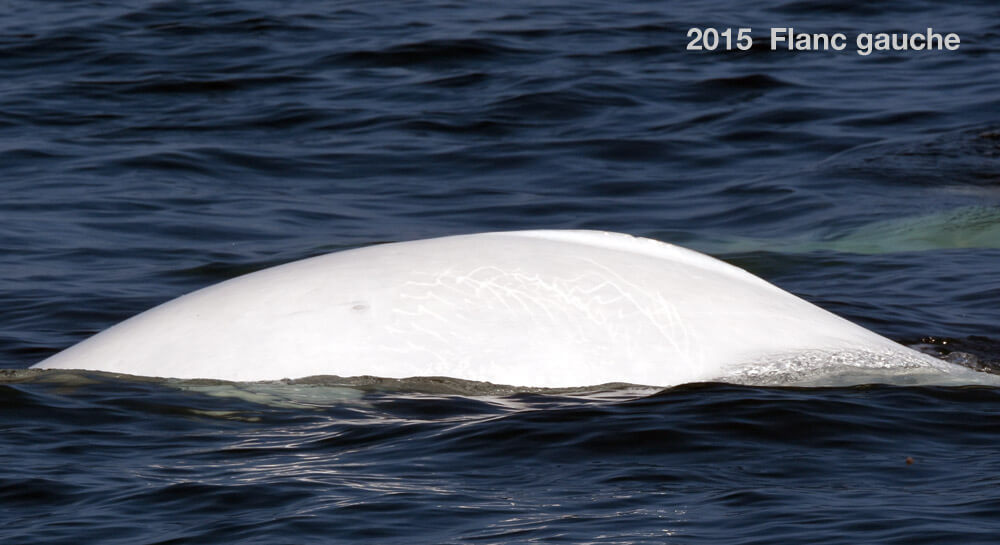Dorothy
Beluga


Adopted by Adelaide Gomer, Mathijs Wittink and Anneke
-
ID number
DL2757
-
Sex
Unknown
-
Year of birth
Around 2000
-
Known Since
2008
Distinctive traits
Dorothy has several distinctive markings on its left flank and a notch in the center of its dorsal crest. Its right flank, on the other hand, is difficult to recognize.
Life history
We first met Dorothy in 2008. At the time, it was a young gray beluga. We’ve seen it almost every summer since, and in 2015 it turned almost completely white. In belugas, the color change from gray to white occurs between the ages of 12 and 16. We therefore believe that Dorothy was born around the year 2000. It was also in 2015 that we first saw it with a calf, suggesting that this beluga is a female.
In the summer range, females form large communities in which they look after newborns and youngsters. These communities are attached to traditional territories, and there is little exchange between them.
Dorothy would belongs to the Saguenay community. It has been observed several times with Amalena and Blanche. Associations between females in the same community are generally not stable. They can vary according to the reproductive status of the females, for example whether or not they are pregnant or accompanied by a youngster.
In 2020, Dorothy made its official entry into the photo-ID catalogue of St. Lawrence belugas. Its ID number DL9031 is now replaced by DL2757. Belugas numbered in the 9000s are recently observed animals for whom we don’t have an abundance of information. Once we have accumulated a sufficient number of contacts with the individual to be confident that we will be able to recognize it from any angle, we assign it a number in the 2000s and it becomes officially catalogued. Welcome to the catalogue, Dorothy!
The rest of Dorothy’s story will help us better understand the social and reproductive life of belugas. By understanding how belugas live, we can better protect them.
Observations history in the Estuary
Years in which the animal was not observed Years in which the animal was observed
Latest news
On this autumn day, visibility is good and small waves are rippling the Saguenay. We’re near Anse Saint-Étienne, aboard the Bleuvet, GREMM’s research vessel. Surrounding us is a herd of 25 belugas, made up of adults, calves and a newborn calf. The herd is divided into three groups. In one of them, Dorothy is swimming with three adult belugas and two youngsters, still gray. Also in the herd are Blanchon, Pacalou and DL1508. The wind picks up and blows at speeds of up to 20 km/h. The beautiful little waves turn into sheep, and the belugas start to dive longer. The time for observing the herd is over.
Summer 2016, our 32nd season at sea with the belugas, was again rich in encounters and surprises. We saw Dorothy on at least four occasions. It was accompanied by newborn calves, but our observations do not allow us to confirm whether it was the mother. Eventually, when we have a biopsy, Dorothy’s DNA will reveal details of her family tree.
On September 18, 2016, we are near Île Coquart in the Saguenay Fjord when we meet Dorothy. It is swimming in a herd of around sixty individuals made up of adults, young grays and two newborns. The animals make their way up the Saguenay, finally ending up in Sainte-Marguerite Bay.
This bay appears to be a very special and important site for St. Lawrence belugas, particularly for females and calves, but its role remains poorly understood. It could be a feeding, resting or socialization site for the young. It could even be a calving ground for females like Dorothy, but this hypothesis remains to be verified.
Dorothy is near Anse à la barque in the Saguenay fjord, just upstream from the ferries. Bleuvet’s team spotted it among a herd of some forty individuals. The herd is made up of adults and several young gray individuals. Dorothy swims in the company of a well-known female, Blanche. Since 2008, they have frequently been seen together. The herd heads for Sainte-Marguerite Bay, often the final destination of the Saguenay female community.
Our boat drifts towards Ile Rouge, which lies in the middle of the mouth of the Saguenay Fjord. Dorothy swims among a herd of 25 individuals, comprising adults and calves, including 4 newborns. We can’t recognize the females accompanying the calves, but we do notice an old acquaintance alongside Dorothy, Géographis. The animals are quiet, billowing or “milling”, i.e. circling, diving and resurfacing in the same place over and over again. This behavior is often associated with feeding. The animals’ behavior soon changes, as they all swim in a synchronized straight line towards the south shore off Cacouna.
Sponsors
Adelaide Gomer adopted Tepui (2000) and Dorothy (2016).
Mathijs et Anneke Wittink adopted Dorothy (2016).



